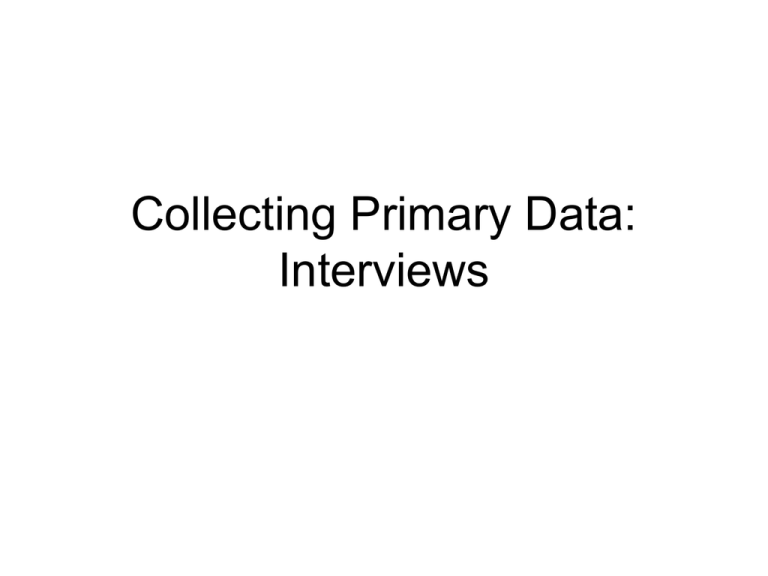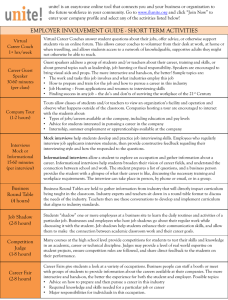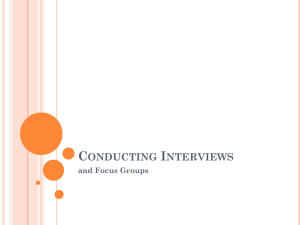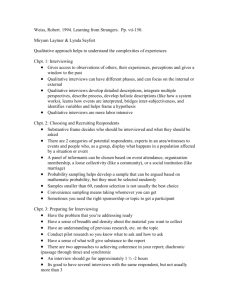Chapter 14 - Collecting Primary Data: Interviews
advertisement

Collecting Primary Data: Interviews Objectives After this session you will be able to: • Describe and choose between structured, semistructured, non-directive, focused and informal interviews on the basis of the objectives of the research. • Select between using interviews and selfcompleted questionnaires. • Produce valid and reliable interview schedules. • Conduct an interview skillfully, tactfully, safely and ethically. Definition An interview is a conversation between people in which one person has the role of researcher. Interviews or questionnaires? Interviews • Need for highly personalized data. • Opportunities required for probing. • A good return rate is important. • Respondents are not fluent in the native language of the country, or have writing difficulties. Questionnaires • Large numbers of respondents must be reached. • Better reliability of data is desired. Pros and cons of interviews Pros • In depth exploration. • Clarification of answers. • Probes. • Eliciting perspectives and stories. Cons • Time (arranging then conducting interviews). • Costs. • Sample size needs to be limited. • Transcription of data (10 hours for a onehour interview). Getting an interview may depend on… • Your status: Are you ‘internal’ to the organization or completing a research project for an external client? If an internal researcher, how senior are you in the organization – and how senior compared to the interviewee? • The project: Is the project of interest to the potential respondent? Is there a potential pay-off? • Yourself: Do you seem trustworthy, personable and professional? Types of interview (1) Volume of data • Structured: Pre-prepared, standardized questions recorded on schedule • Semi-structured: A list of questions, but the order may change and not all may be used. • Non-directive: No pre-prepared questions, but getting the respondent to talk about the subject. Check for accuracy and rephrase answers. Types of interview (2) Volume of data • Focused: Interviewer has some prior knowledge of respondent’s issues and is able to refocus the interview if respondent strays • Informal conversational: No preplanning. Questions generated spontaneously as interview progresses Interviewing skills • • • • • • • • Preparation (pens, paper, seating arrangements, tape recorder). Building rapport with respondent. Use of language. Active listening skills. Improvising. Testing and summarizing understanding Recording data. Closing the interview. Tape recording interviews • Tape record if possible. • But ask permission first. • Ensure equipment works. • Doing own transcription allows for researcher to interact with the data. When interviewing DO • Seek permission to ask questions. • Ask mixture of open and closed questions. • Listen carefully. • Repeat responses. • Ask additional probing questions. • Be sensitive to misunderstandings and/or embarrassment. • Abandon interview if it is not working. When interviewing DON’T: • • • • Ask leading questions. Agree or disagree with the response. Rush the questions. Continue if the respondent appears upset, angry or withdrawn. Questioning skills Avoid questions that: • Contain jargon. • Use prejudicial language. • Are ambiguous. • Lead the respondent. • Include double questions. • Contain hypothetical statements. • Probe personal or sensitive issues. • Require memory recall or knowledge the respondent does not possess. Internal validity Validity is strengthened by: • Using interview techniques that build rapport and trust, thus giving informants the scope to express themselves. • Prompting informants to illustrate and expand on their initial responses. • Ensuring that the interview process is sufficiently long for subjects to be explored in depth. • Constructing interviewing schedules that contain questions drawn from the literature and from pilot work with respondents. Arksey and Knight (1999) External validity • Select a sample that allows for a subject to be viewed from all relevant perspectives. • Keep increasing the sample size, or subsamples that represent different perspectives, until no new viewpoints are emerging from the data. Arksey and Knight (1999) Dangers of bias • Departures from the interviewing instructions. • Poor maintenance of rapport with the respondent. • Altering factual questions. • Rephrasing of attitude questions. • Careless prompting. • Biased probes. • Asking questions out of sequence. Oppenheim (1999) Dealing with problem respondents • Acting ethically means being sensitive to respondents who may be: – Nervous – Stressed – Embarrassed – Lacking in subject knowledge • Be prepared to terminate interview. Why focus groups? • • • • Low cost. Stimulates ideas. ‘Safe’ environment. Gratifying for participants. • Generates multiple perspectives. • Key themes tend to emerge. Using a focus group • • • • Set up room. Arrange microphones. Get permission to record. Set out purpose of session. • People introduce themselves. • Ask open questions. • Minimize own (facilitator’s) interventions. Summary • Interviews can be divided into five categories ranging from the informal conversational to the completely structured. • The choice of approach will depend on the objectives of the research, with structured interviews eliciting more quantitative data and unstructured or focused interviews, qualitative. • The danger of bias in interviews stems not only from the type of questions asked but the way in which they are articulated by the interviewer. • Interviewing is a skill and includes the ability to build rapport with respondents while maintaining detachment, and observing and listening in order to keep control of the interview. • Be aware of some of the safety issues involved in interviewing, particularly interviewing people in their own homes or in isolated work situations. Use common sense to avoid potentially dangerous situations. Carry a mobile phone and always let close confidants know where you are. • Ethical issues are of paramount importance since confidentiality may be more difficult to maintain than in other forms of data gathering, such as postal questionnaires.









